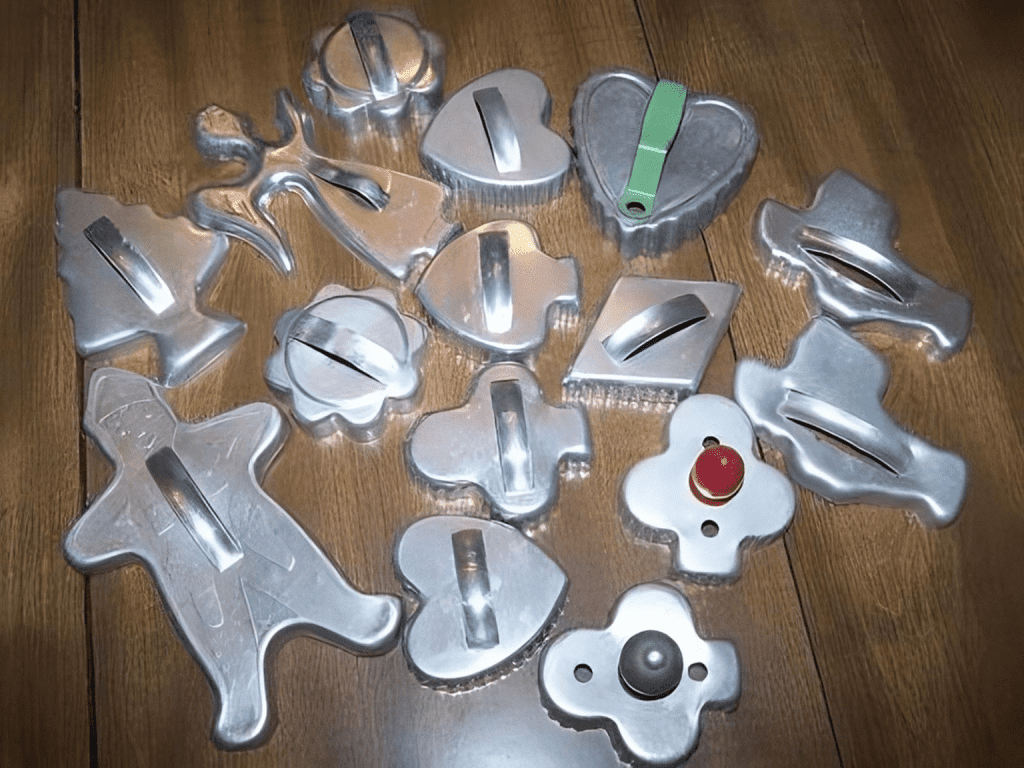Cookie cutters hold a special place in holiday baking traditions, evoking memories of sugary aromas, flour-dusted counters, and the familiar shapes of stars, reindeer, and gingerbread people. Many of us have fond memories of vintage tin or aluminum cutters passed down through generations. But where did these delightful tools come from, and how did they evolve into the diverse designs we see today? Let’s dive into the charming history of cookie cutters and their journey from practical kitchen tools to beloved collectibles.
Early Origins: The Dawn of Shaped Treats

While shaped cakes and pastries date back as far as ancient Egypt, cookie cutters as we know them today likely originated in Italy before the 1400s. These early cutters were used across Europe and were eventually referred to as “imprint cutters,” which both cut the dough and pressed a design onto the cookie’s surface. By the 1500s, these tools were already widely used throughout Europe and the United Kingdom, marking the beginning of a centuries-old tradition.
Outside of the United States, early cutters were known as “biscuit cutters” and were typically crafted by hand. In Germany’s Black Forest region, cookie molds and cutters were intricately carved out of wood, creating detailed shapes and patterns. As European immigrants, especially Dutch and German settlers, migrated to America, they brought with them their rich baking traditions, including the practice of shaping and decorating Christmas cookies.
Colonial America: The Shift to Metal Cutters
In early America, cookie cutters were typically crafted from wood, reflecting the resourcefulness of Colonial kitchens. However, bakers soon realized that metal was far superior for cutting dough, and by the early 1700s, tin and copper became the materials of choice. Colonial bakers used thin strips of metal to shape cookies, but due to strict British control over tin production, tin was expensive and had to be imported.
Consequently, pre-Revolutionary cookie cutters were often made from small, carefully preserved tin scraps. These cutters were flat, as adding handles would have wasted valuable metal. It’s believed that cookie cutters with handles only started appearing after American Independence. Many early cutters were soldered with lead-based material, meaning they’re now unsafe for food use. Nevertheless, these early American cookie cutters set the stage for a beloved holiday tradition that still flourishes today.
Mass Production: From Tin to Aluminum and Beyond
By the 19th century, metal cookie cutters were being mass-produced across America, making them more accessible to households. Tin remained popular until around the 1930s when aluminum emerged as a lightweight, durable alternative. The introduction of plastic further diversified cookie cutter production, creating colorful, durable options that were inexpensive to manufacture.
Even with modern materials, copper has remained a favorite due to its durability and aesthetic appeal. As cookie cutter materials evolved, so did the variety of shapes and designs. From simple stars and circles to elaborate animal figures and holiday symbols, cookie cutters began to reflect the creative spirit of bakers everywhere. Today, thanks to 3D printing, the options are virtually endless—any shape you can imagine can now be turned into a cookie cutter!
Cookie Cutters as Collectibles: A Growing Community
While cookie cutters are usually inexpensive, that hasn’t stopped enthusiasts from collecting them. The Cookie Cutter Collectors Club, for example, is a community of passionate collectors who celebrate these delightful tools. The club even oversees the National Cookie Cutter Historical Museum in Joplin, Missouri, where visitors can explore the history and variety of cookie cutters from around the world. In 1996, the club successfully petitioned for National Cookie Cutter Week, celebrated annually during the first week of December.

Some collectors have gathered thousands of cookie cutters, amassing rare designs and vintage finds from across the globe. A collector from Minnesota is rumored to own 40,000 cutters, while another uses her collection for creative culinary purposes beyond cookies, shaping everything from sandwiches and fruit to polenta and mashed potatoes. For these collectors, cookie cutters represent both a piece of history and a source of endless culinary inspiration.
Grandma’s Collection: A Nostalgic Look Back
Many of us can recall family collections of cookie cutters, often handed down from grandparents who cherished holiday baking traditions. These collections typically include winter holiday favorites: reindeer, Christmas trees, stars, and gingerbread men and women. Some cutters were a bit whimsical—like a bear or a duck—while others took on a folk art aesthetic. Each cutter has its own story and a specific memory, from the perfectly shaped stars to the reindeer whose long, fragile legs often broke, allowing for an “accidental” taste of raw cookie dough.
These cutters not only represented the shapes of the season but also became part of family folklore. They created a sense of continuity, as each generation added new shapes to the collection and continued the tradition of holiday baking.
Creative Uses: Beyond Just Cookies
While cookies remain the most popular use for these cutters, creative bakers and home cooks have found new ways to put them to use. Cutters can shape sandwiches, tortillas, sticky rice, and even pizza, adding a fun twist to otherwise ordinary meals. Using cutters for food presentation is a fantastic way to encourage kids (and sometimes adults!) to try new foods or make mealtime more enjoyable.
Beyond the kitchen, cookie cutters can also double as DIY tools for crafting. Many use cutters to create soap shapes, ornaments, and even decorative shapes for wreaths and holiday decor. The versatility of cookie cutters, combined with their unique designs, makes them a cherished tool for culinary and creative expression alike.

Preserving Vintage Cookie Cutters: Tips for Collectors
For those interested in collecting or preserving vintage cookie cutters, proper care is essential. Metal cutters, especially tin and aluminum, should be washed by hand and dried thoroughly to prevent rusting. Avoid using abrasive scrubbers on aluminum and tin cutters, as they can damage the surface. If you’re lucky enough to own copper cutters, polish them occasionally with a gentle cleaner to maintain their shine.
Plastic cutters are usually dishwasher-safe, but vintage plastic can become brittle, so it’s best to wash them by hand. For display, consider placing cutters in a shadow box or a glass display cabinet to showcase their charm while keeping them protected.
Conclusion: Celebrating the Charm and History of Cookie Cutters
From their origins in Europe to their place in today’s kitchens, cookie cutters have journeyed through history as both practical tools and objects of nostalgia. Whether you’re using them to bake holiday treats, add flair to everyday meals, or preserve them as collectibles, cookie cutters hold a unique place in the heart of culinary tradition. They bring joy to bakers of all ages, inspire creativity, and offer a sweet reminder of the simple pleasures in life. So next time you roll out a batch of dough, remember—you’re not just making cookies; you’re part of a tradition that spans centuries.


